
In today’s business landscape, it’s crucial for organisations to understand the significance of talent management. Your employees are your most valuable assets, and by embracing a comprehensive talent management approach, you can enhance your business performance, boost employee satisfaction, and foster loyalty within your workforce.
In this blog post, we’ll delve into why talent management matters for businesses and break down the key components of successful talent management strategies.
Key Takeaways
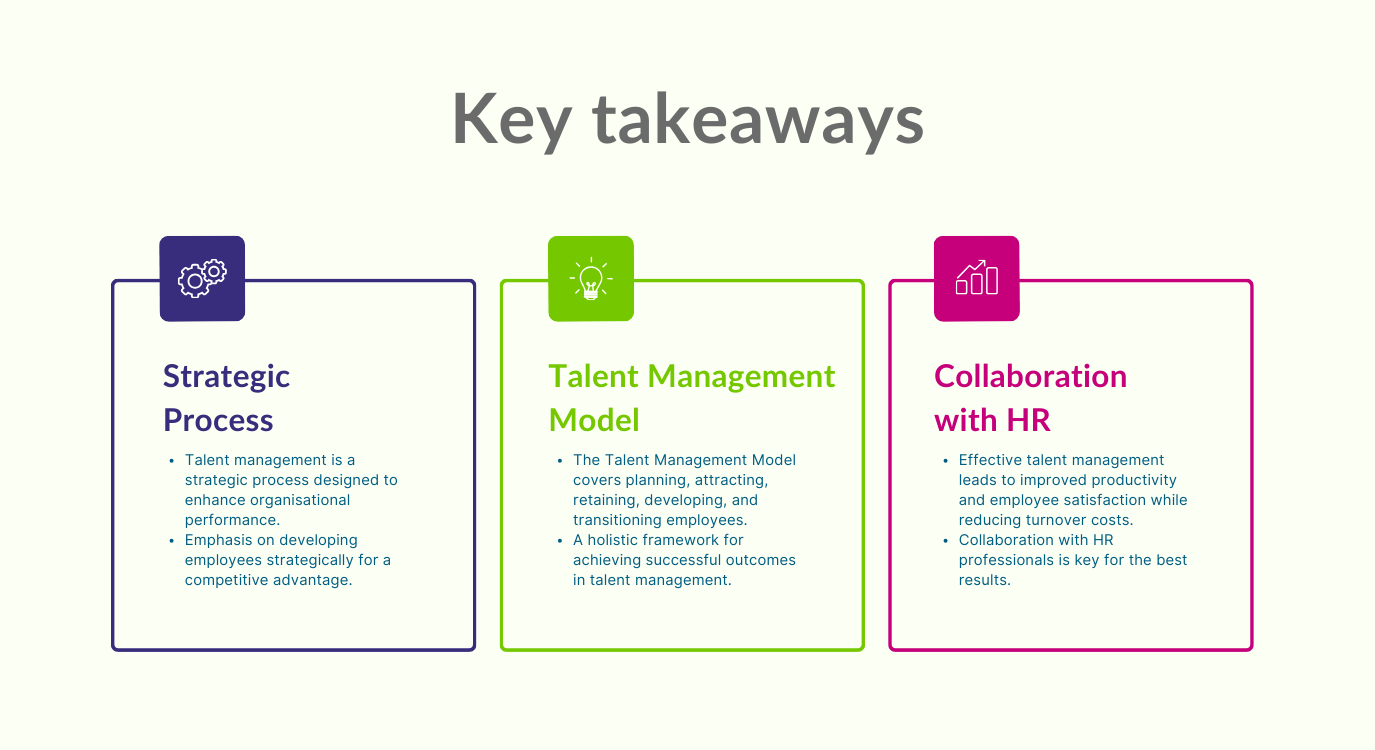
- Talent management is a strategic process focused on developing employees to create a competitive advantage and optimise organisational performance.
- The Talent Management Model covers planning, attracting, retaining, developing, and transitioning employees for successful outcomes.
- Effective talent management leads to improved productivity and employee satisfaction while reducing turnover costs. Collaboration with HR professionals is key for the best results.
Understanding Talent Management
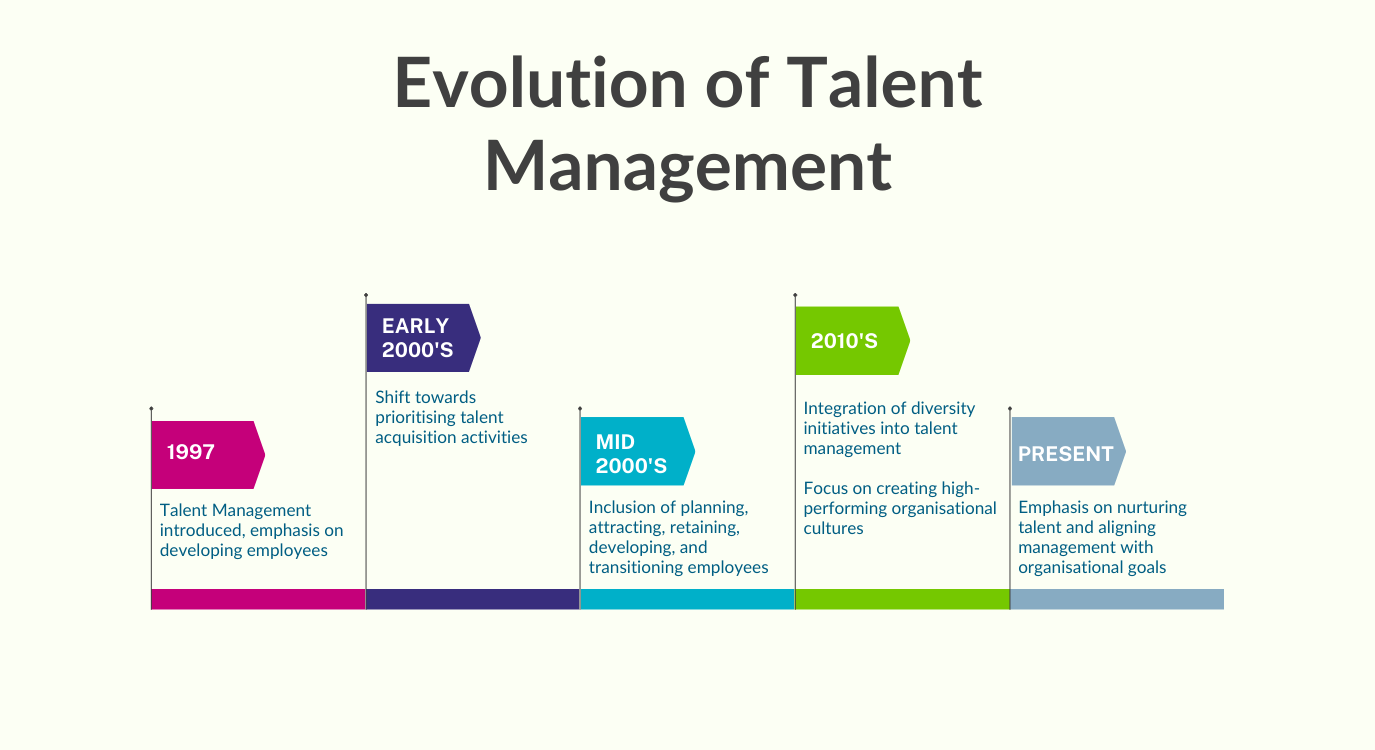
Talent management, introduced as a strategic process in 1997, is a focused effort on developing employees to drive organisational success. This approach emphasises individuals with the potential to positively impact corporate performance, both in the short term and in the long run. Prioritising talent acquisition activities doesn’t just give your business a competitive edge but also cultivates top talent and boosts employee commitment, resulting in heightened productivity.
Effective human resources management encompasses various essential components, including recruitment, training, growth opportunities, and talent retention. The aim is to create a high-performing organisational culture, bolstering your employer’s brand value and promoting workforce diversity. Collectively, these factors contribute to achieving a higher level of competence compared to competitors with similar talent management practices.
Streamlining individual hiring practices and nurturing talent are equally critical aspects to ensure optimal results right from the start. Effectively managing your pool of talented individuals contributes to the successful orchestration of people-centric business operations and overall organisational success.
The Talent Management Model
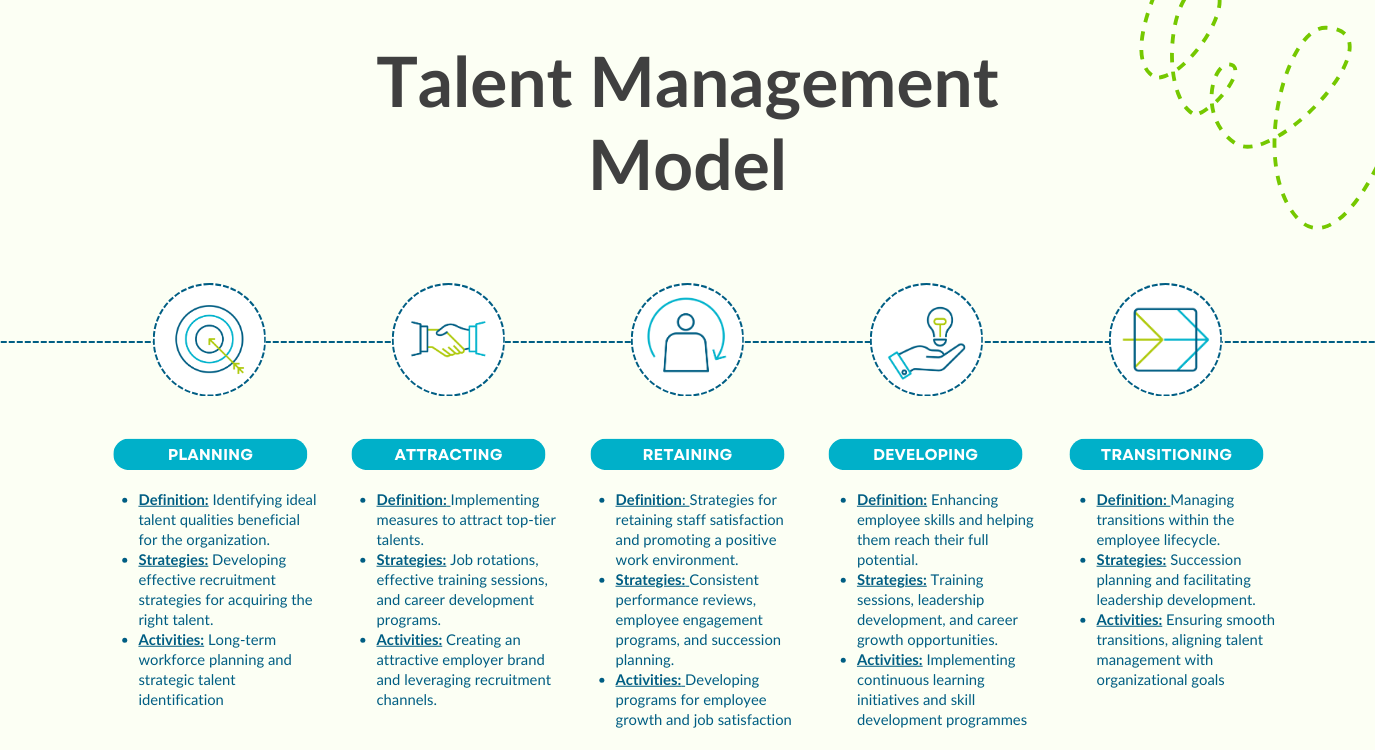
Talent management models are Human Resources strategies designed to establish a comprehensive framework for employee retention and growth. The planning aspect of this model identifies ideal talent qualities beneficial for an organisation and structures effective recruitment strategies. Implementing measures, such as job rotations, training sessions, and career development programmes, helps employees reach their full potential.
To ensure the successful implementation of these practices, employers must consider every stage in the employee lifecycle. This includes recruitment, retaining staff satisfaction, and implementing consistent performance reviews and succession planning. These activities not only create a positive work environment but also align talent management with organisational goals, leading to increased productivity and a clear competitive advantage.

Developing a Talent Management Strategy
Constructing a talent management strategy that aligns with an organisation’s business objectives starts with identifying strategic goals. This clarity guides the precise outcomes to be achieved through effective workforce and resource management. Talent development, which includes training, team creation, leadership development, and job rotations, prepares your team to tackle future challenges efficiently.
Succession planning and leadership development are vital components of a long-lasting talent management strategy. This approach allows organisations to develop a pool of capable personnel, delivering optimal performance and reducing turnover costs.
It’s crucial for businesses not to overlook key elements like identifying the best-fit candidates and implementing an effective human capital management framework. Neglecting these factors risks hindering your potential success, especially in talent management processes.
Key Components of the Talent Management Process
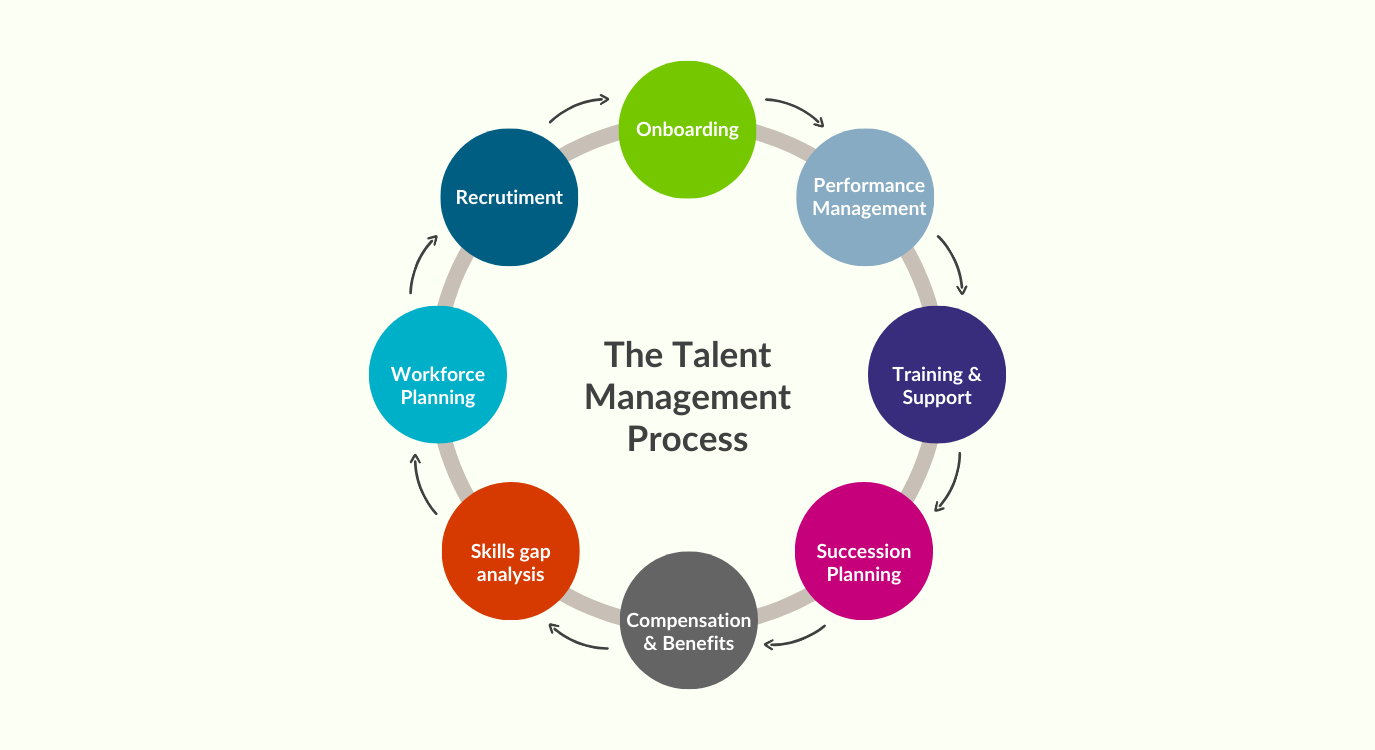
The talent management process is a continuous cycle, involving selection, hiring, training, development, motivation, and performance monitoring. Selection identifies the best candidates, onboarding ensures they are properly hired, training addresses skills gaps, and performance management develops employees within a supportive workplace. Motivation plays a critical role in maintaining an energetic and capable workforce, contributing to internal organisational performance improvement and competitive success.
The Importance of Talent Management
To achieve strategic objectives, organisations must employ effective talent management practices. Prioritising the right practices can have a profound impact on delivering results and reducing costly employee turnover rates. By managing existing talent effectively and attracting fresh skills, organisations can retain personnel more efficiently and foster enthusiasm among staff members.
Recent statistics highlight the significance of sound talent management. Companies that efficiently hire and retain employees reported outperforming rivals, underlining the paramount importance of these strategies.
Benefits of Effective Talent Management
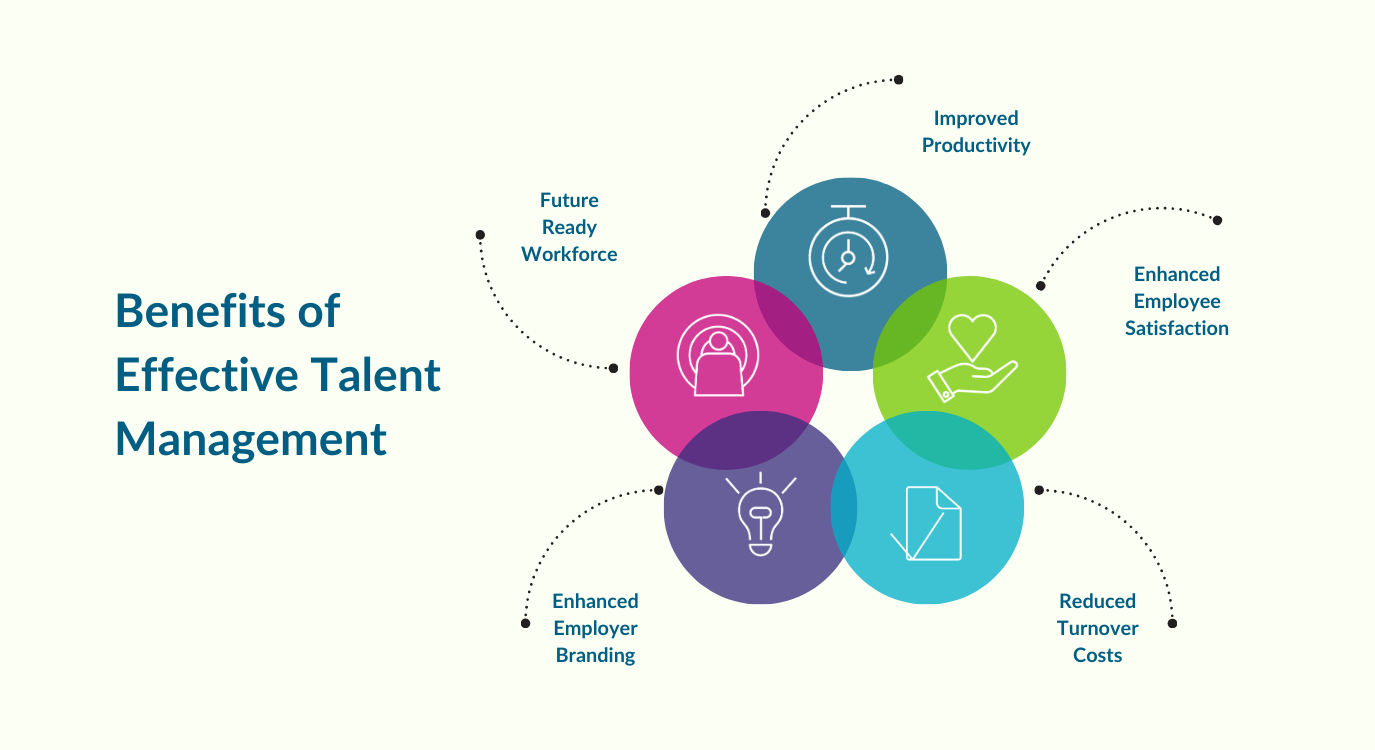
Implementing successful talent management strategies offers several advantages. One influential benefit is the creation of a future-ready workforce, ensuring the business is prepared for potential expansion or operational changes. Effective personnel management significantly contributes to improved productivity, employee satisfaction, and reduced turnover costs. Efficient talent management also enhances employer branding, making the organisation more attractive to top talents.
In summary, the benefits of competent talent management extend beyond individual rewards, positively impacting the entire organisation, particularly in the face of fierce competition in the constantly evolving global business landscape.
Resourcing and Talent Management
Talent management strategies focus on finding the best candidates for job openings through a mix of internal and external resources. Balancing the promotion of current talent with introducing fresh perspectives creates diverse workforces. Tailored hiring pools acquire top-tier talents and offer staff opportunities for training, career development, and job rotations within positive workplace environments. Developing talent pipelines is equally essential, providing growth prospects before initiating new recruitment.
Talent Acquisition vs. Talent Management
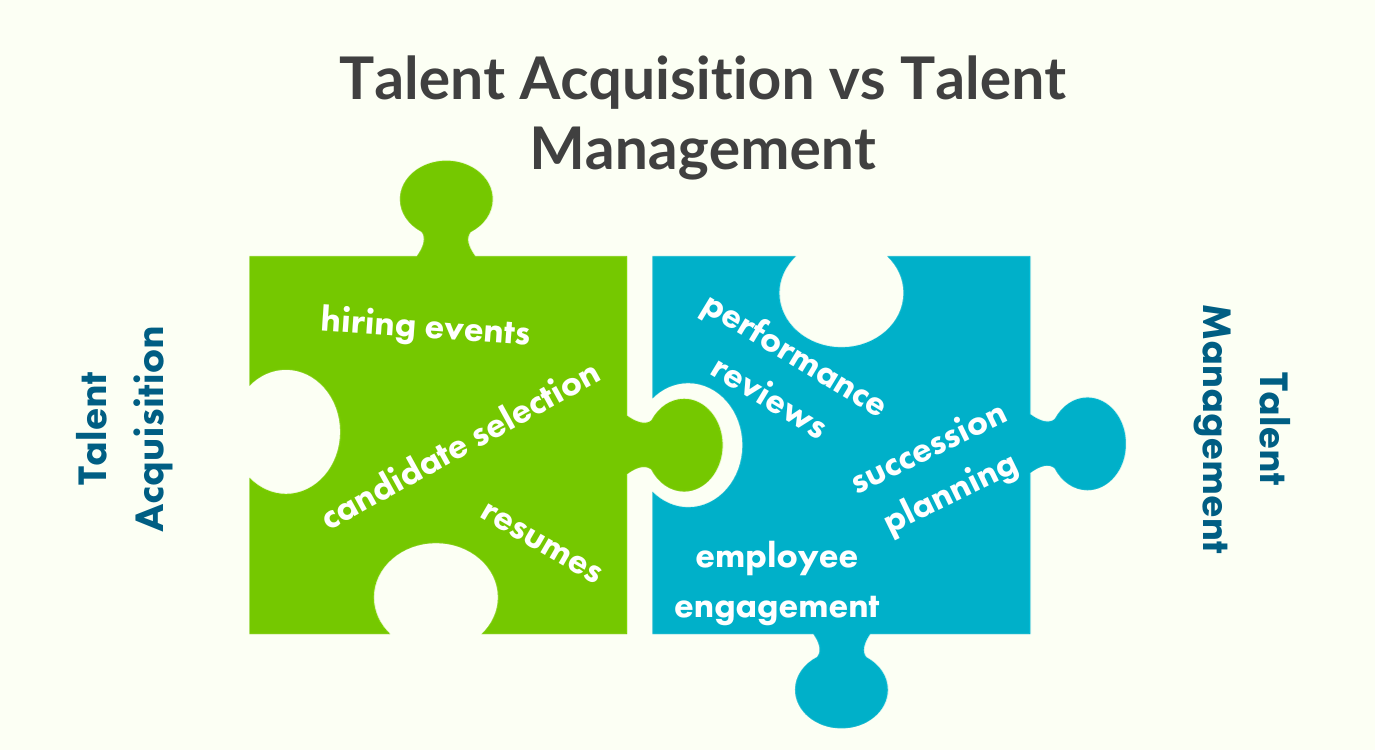
Talent acquisition and talent management are distinct but interconnected processes within an organisation. Talent acquisition is the initial step, focusing on identifying candidates who fit into your company’s culture. Talent management follows, involving existing staff in performance reviews, succession planning, and employee engagement programmes. It helps build their knowledge base and capabilities over time, maintaining high levels of growth potential.
Who Should Implement Talent Management?
All organisations, regardless of size or sector, should prioritise talent management due to its tangible impact on performance and worker morale. Collaboration between HR professionals, senior staff members, and supervisors ensures that strategies align with corporate objectives and reinforce core values. Senior staff play a crucial role in nurturing potential leaders and strategically recruiting top talent, leading to increased productivity and success.
In conclusion, companies should foster closer collaboration between managers, CEOs, and those responsible for overseeing workforce talents. This collaboration efficiently aligns the ambitions of all stakeholders, consistently leading them towards recognising success over failure. This alignment is achieved through informed decision-making, supported by expert insights, and a shared vision for enhancing positive workplace conditions and advancing individual aspirations. This approach relies on a sound strategy, providing lasting value and effectively winning the hearts and minds of people, all while anticipating the unknown challenges that lie ahead.
Creating a Positive Work Environment through Talent Management
Effective talent management practices are paramount for establishing a positive work environment that leads to higher productivity, employee engagement, and skills development. Concentrating on employee growth and satisfaction enables organisations to craft supportive settings where staff feel valued while contributing to the company’s success. This positive impact on an organisation’s reputation increases its employer brand image, attracting more talented individuals.
Talent management strategies invest in activities that nurture workplace positivity. This leads to long-term benefits, including effective retention and continuous improvement for workers at every level, from new recruits to experienced staff.
Summary
Effective talent management practices are crucial for establishing a positive work environment, leading to higher productivity, employee engagement, and skills development. It also enhances the organisation’s employer brand, attracting top talents and securing valuable contributors. Talent management strategies invest in activities that nurture workplace positivity, resulting in long-term benefits, including effective retention and continuous improvement.
Frequently Asked Questions (FAQs)
1. What is the role of strategic talent management in a company’s business strategy?
Strategic talent management is a crucial element of a company’s business strategy. It involves identifying and nurturing top talent to achieve long-term organisational goals. By implementing an effective talent management strategy, companies can align their human resource management with their broader business objectives.
2. How can managing talent within the organisation benefit existing employees?
Managing talent within the organisation can significantly benefit existing employees. Through skill development, career growth opportunities, and a positive work environment, existing employees are more likely to feel valued and motivated. This leads to increased job satisfaction and productivity among the workforce.
3. What are talent pools, and how do they relate to the talent acquisition process?
Talent pools refer to a group of potential candidates who possess the skills and attributes that align with a company’s talent management strategy. These pools are essential for the talent acquisition process as they provide a source of top-tier talent that can be tapped into when specific roles need to be filled.
4. How does an effective talent management strategy enhance the overall human resource management of an organisation?
An effective talent management strategy is integral to overall human resource management. It ensures that the right employees are recruited, trained, and developed to support the organisation’s business strategy. This strategic approach helps in maintaining a skilled and motivated workforce.
5. Can a strong talent management strategy be a key component of a company’s business strategy?
Yes, a strong talent management strategy is often a key component of a company’s business strategy. It ensures that the organisation has the right people in place to execute its business plans effectively. By aligning talent management with business objectives, companies can gain a competitive edge and drive success.







